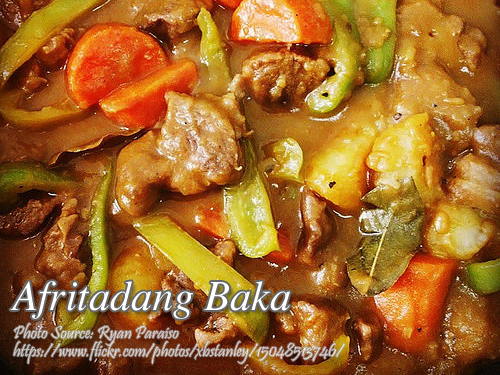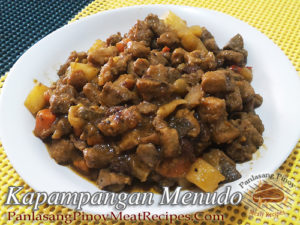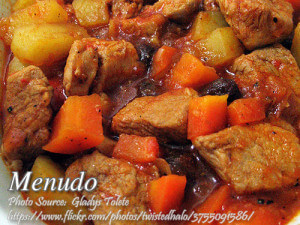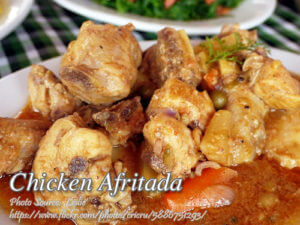Beef afritada is a variation of the popular chicken afritada. Which is a basic Filipino tomato based chicken stew. Instead of chicken, you use beef. Actually, afritada is the easiest compared to other Filipino tomato based stew like menudo, caldereta or mechado.
So I bet this afritada is an easy dish for you to prepare if you are scared to cook beef caldereta or beef mechado. Or this dish could be a good excuse if you made a mistake while cooking beef mechado because you didn’t follow the recipe and someone ask you what are you cooking? then just smile and say “It’s beef afritada!”.
Beef Afritada: A Family Favorite, Reinvented
I can still remember the first time I tasted beef afritada, and it was a moment so vivid in my memory that every spoonful of this rich, savory stew brings me back to my childhood. My Tita Susan was the family’s unofficial chef, and whenever there was a celebration—or even just an ordinary Sunday lunch—she would always be the one standing over the stove, apron tied tight around her waist, stirring a large pot with her signature smile.
When she made afritada, she usually used chicken, but one day, she decided to experiment with beef. This variation became an instant hit, and to this day, I swear that her afritada had the power to bring our family closer together. We’d gather around the table, bowls filled with the hearty dish, and Tita Susan would always remind us that sometimes, the simplest recipes are the ones that touch the heart the most.
The Basics of Beef Afritada
Beef afritada is a humble yet incredibly satisfying Filipino stew made with tender beef chunks, potatoes, carrots, and vibrant bell peppers, all simmered in a rich, tomato-based sauce. Unlike more complex dishes like beef caldereta or mechado, this dish is relatively simple, perfect for anyone new to Filipino cooking. In fact, if you’ve ever been intimidated by the idea of tackling a beef stew, this is the perfect gateway recipe.
I remember my cousin Junjun once confessing that he almost gave up cooking Filipino stews because his beef caldereta always ended up too tough. Then I shared with him this recipe, and the relief on his face was priceless. The magic of beef afritada lies in its simplicity, yet the taste is anything but basic.
How Tender Beef Transforms the Dish
One of the first lessons I learned when cooking beef afritada is that patience pays off. When you boil the beef chunks in just enough water to cover them, you ensure that the meat becomes melt-in-your-mouth tender. My Uncle Boy would always say, “Huwag kang nagmamadali sa pagluto ng baka,” or “Never rush cooking beef,” and I swear, that advice has saved many meals. Boiling the beef gently also creates a flavorful broth that you’ll use later to enrich the tomato sauce, a crucial element that adds depth to the dish.
For the beginner cook, this might seem like an extra step, but trust me, it makes a world of difference. Beef that hasn’t been properly tenderized will end up chewy and tough, taking away from the comfort that this dish promises. So, take your time and let the meat simmer until it’s just right.
Building Layers of Flavor
Once the beef is tender, it’s time to layer the flavors. In my family, this part is almost ceremonial. You start by sautéing minced garlic in hot oil until it’s fragrant, and the smell fills the kitchen. My younger sister, Liza, used to joke that this was the point where everyone magically appeared in the kitchen, drawn in by the aroma. Next come the onions and fresh tomatoes, which you cook until they’re soft and starting to meld into a sweet, savory base.
Then, the vibrant bell peppers join the party. Their crispness and sweet, slightly smoky flavor bring brightness to the dish. If you’re wondering why we use both red and green bell peppers, it’s not just for the beautiful color contrast. My Lolo Pedro, who grew up farming in the province, used to say that the different peppers add layers of flavor, making the dish more complex than it seems.
Why the Tomato Sauce Matters
Tomato sauce is the heart of afritada, but here’s a little secret: using the right amount is key. Too much, and the stew becomes overly acidic; too little, and you won’t get that signature richness. When you pour in the tomato sauce and some of the reserved beef broth, the magic begins. The flavors start to marry, and you’re left with a stew that’s hearty and robust, perfect for spooning over warm, fluffy rice.
We always let the dish simmer long enough for the potatoes and carrots to cook through, their starches thickening the sauce. My father, who claims to be an afritada “expert,” insists that you know the stew is ready when you can easily cut the potatoes with the side of a spoon. And don’t forget the bay leaves! These aromatic leaves add a subtle, earthy flavor that ties everything together.
A Dish Rich in History and Love
Afritada, whether made with chicken or beef, has a rich history rooted in Filipino-Spanish cuisine. The name itself comes from the Spanish word fritada, which means “fried.” It reflects the initial step of frying or sautéing the ingredients to develop flavor. This dish has evolved over the years, adapting to local ingredients and preferences, yet it remains a true comfort food staple.
There’s something about beef afritada that feels like a warm hug on a plate. It’s the kind of dish that brings families together, a reminder of home and tradition. Every time I make this recipe, I think of Tita Susan and how one simple pot of stew could make a house feel like a home. So, the next time you’re in the mood for something hearty and delicious, give this dish a try. Who knows, maybe it will create cherished memories for you, just as it has for me.
Serve your beef afritada hot, with a generous serving of rice, and share it with loved ones. Because, at the end of the day, food tastes best when enjoyed together.
How to Cook Beef Afritada (Afritadang Baka)
Ingredients
- 1/2 kilo beef briskets or sirloin cut into chunks
- 3 Tbsp cooking oil
- 5 cloves minced garlic
- 1 pc onion chopped
- 2 pcs tomatoes chopped
- 1/2 cup red and green bell peppers cut into strips
- 1 pc beef broth cube
- 1/8 cup tomato sauce
- 1 cup beef broth
- 1 pc carrots slice into wedges
- 2 pcs medium size potatoes quartered
- 3 pcs bay leaves
- fish sauce to taste
- ground black pepper to taste
Instructions
How to Cook Beef Afritada:
- In a pot, boil the beef chunks in water, just enough to cover the meat. Cook until tender.
- Remove the beef chunks from the broth and set aside. Save the broth.
- In a saucepan, heat some cooking oil and saute garlic until fragrant.
- Then add onions and tomatoes. Saute until tender. Add the red and green bell peppers.
- Add in the beef cubes and mix well. Pour tomato sauce then followed by the beef broth. Mix well.
- Add the carrots, potatoes and the bay leaves. Season with patis or fish sauce and ground pepper.
- Simmer until the potatoes are tender. Add more broth if sauce becomes too dry while cooking. Serve hot.
Notes
Cooking Tips:
Tenderize Your Beef for Maximum Flavor For the most tender and flavorful beef afritada, start by simmering the beef chunks in water until they are fully tender. This slow cooking process ensures that the meat absorbs all the rich flavors of the broth. Remember to save the broth as it will be used later to enhance the stew’s depth of flavor. Perfectly Saute Your Aromatics When sautéing garlic, onions, and tomatoes, ensure that they are cooked until they are soft and aromatic. This step is crucial as it forms the flavorful base of your afritada. The longer you sauté these ingredients, the richer and more developed your stew’s taste will be. Balance Your Seasonings Season your afritada carefully with patis (fish sauce) and ground pepper to achieve the perfect balance of flavors. Taste the stew as it simmers and adjust the seasoning gradually, ensuring it complements the natural sweetness of the vegetables and the richness of the tomato sauce. This careful seasoning will make each bite harmonious and delicious.






Hi, what kind of beef cut is suited for this beef afritada recipe?
Hi Julie, beef briskets are suitable and also beef tenderloin.